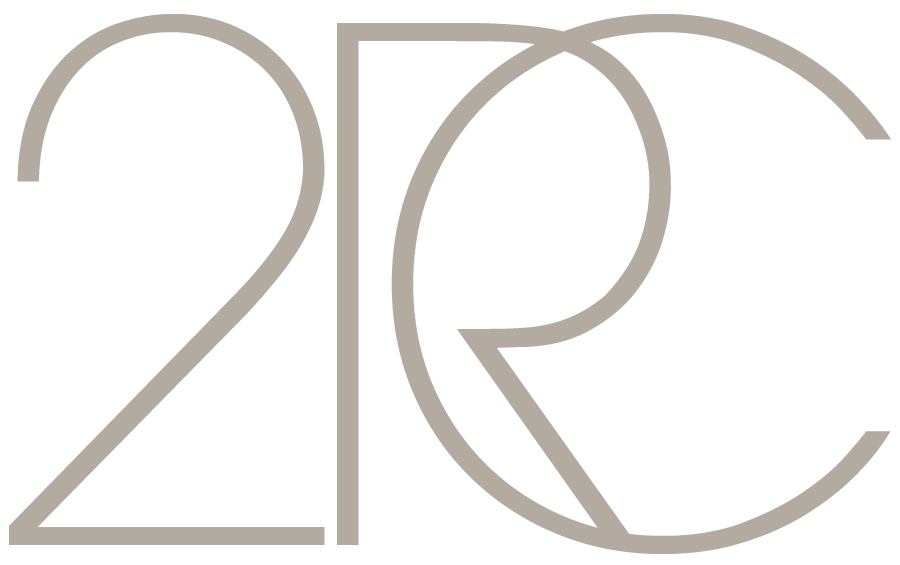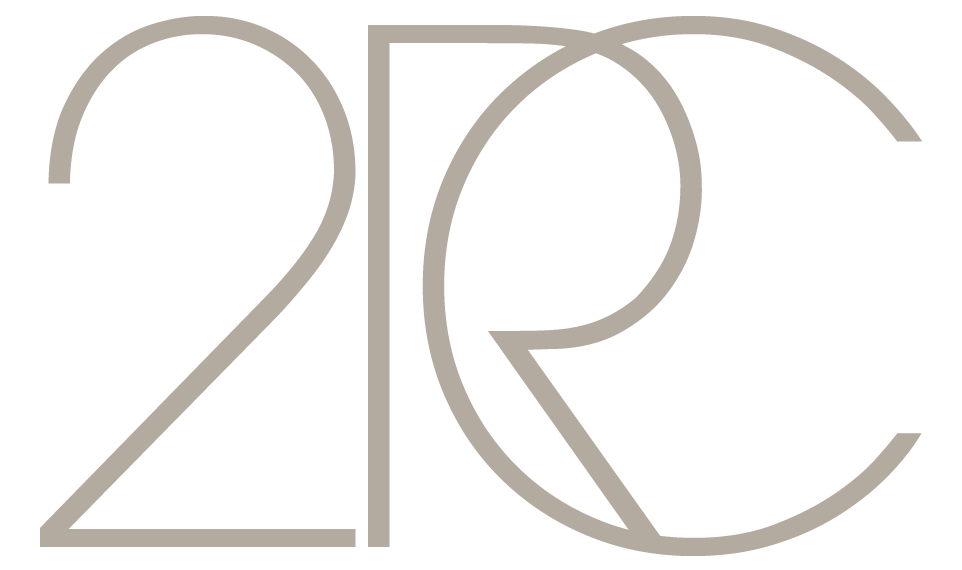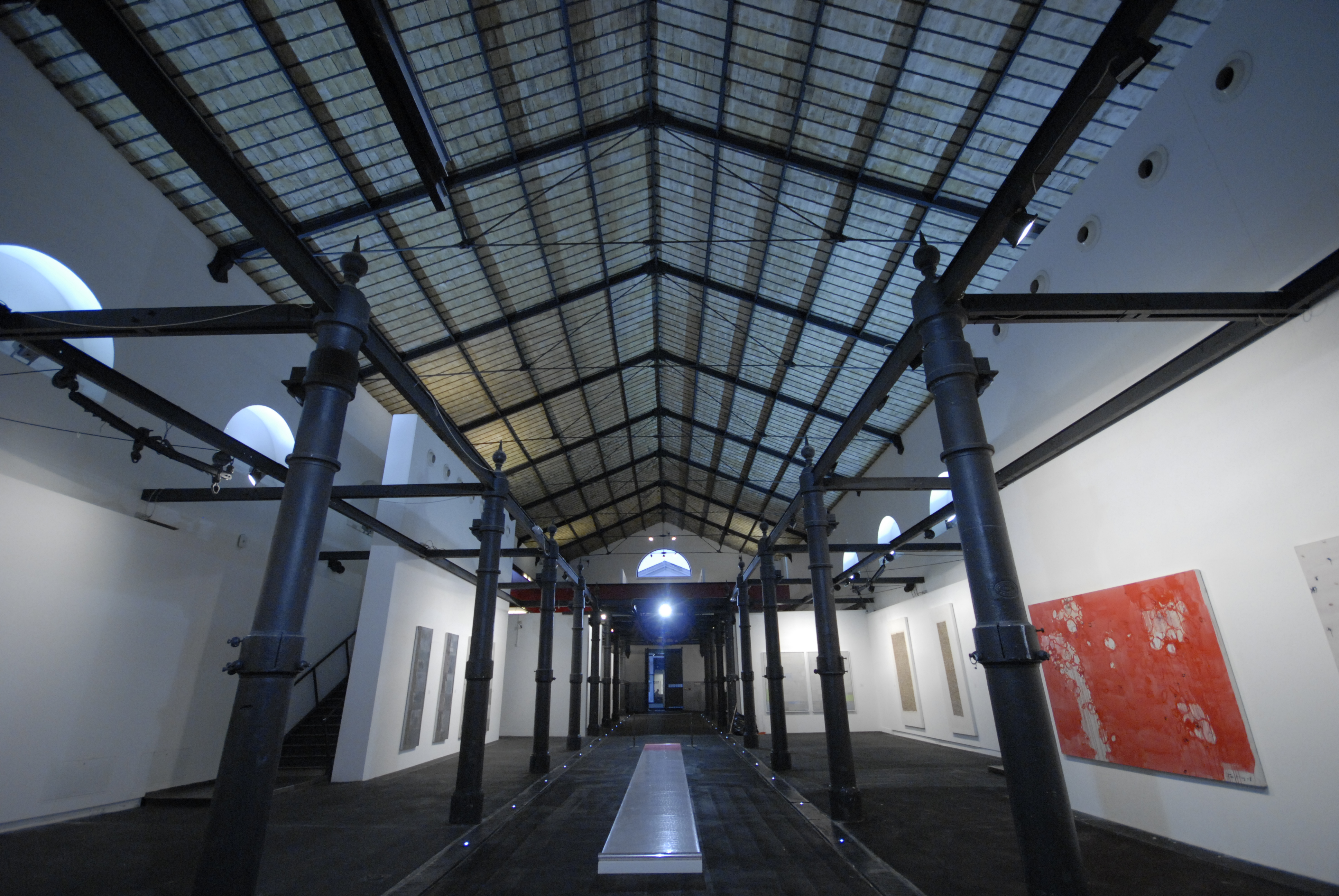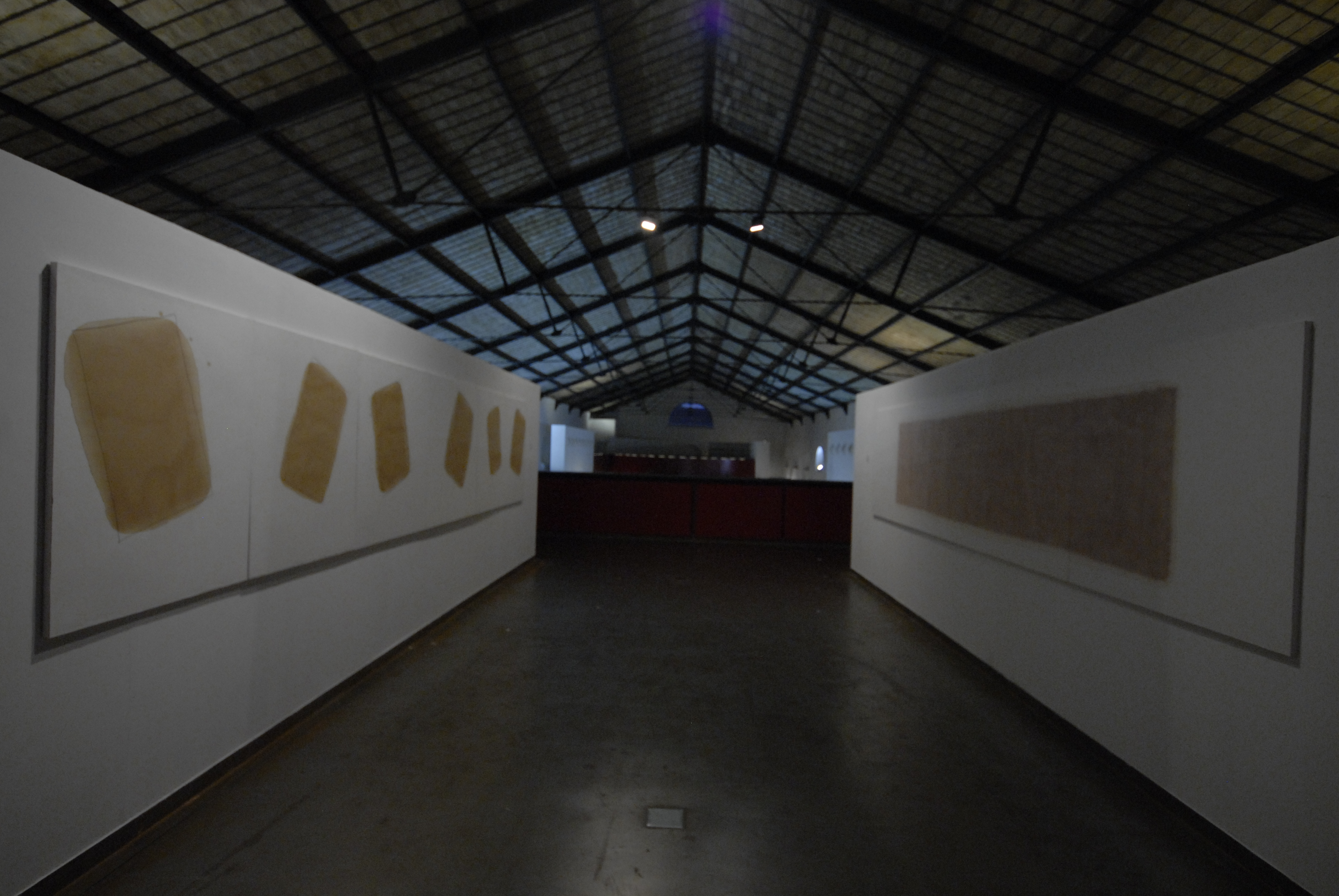The Great Celestial Abstraction
XNUMXst Century Chinese Art
MACROS Testaccio
Rome - 2011
Curated by Achille Bonito Oliva
The modernity of abstract painting by Chinese artists lies in the strong cadence of a work that has been able to find a balance between the creative process and the formal result. Generally, American minimal and conceptual art, aimed at the dematerialization of the object, has favored the design moment over the executive one. Instead, Chinese painters have always worked in the double direction of the concept and the object from the emanating one.
Undoubtedly, the value of planning assumes a decisive weight in the linguistic strategy of Chinese painters, as the bearer of particular articulations of the material they conceived. They prepare an initial form that develops progressively through modular moments that multiply, without repetition, the starting one.
The module becomes the structural element that blends the possibility of form always played on the complexity that potentially infinitely multiplies the surprise of geometry. Conventionally, geometry seems to be the field of pure evidence and inert demonstration, the locus of a mechanical and purely functional rationality. In this sense it seems to favor the premise, as the conclusion becomes the inevitable outcome of a deductive and simply logical process.
Chinese painters have instead founded a different use of geometry, as a prolific field of an irregular reason that likes to develop its principles asymmetrically, adopting surprise and emotion. But these two elements are not contradictory with the design principle, if anything they reinforce it through a pragmatic and not preventive use of descriptive geometry.
It is no coincidence that Chinese painters continually pass from the two-dimensionality of the project to the three-dimensional execution of the form, from the black and white of the idea to the polychromatic articulation of the pyramids or the works created on the walls.
To demonstrate that the idea generates a creative process that is not purely demonstrative but fruitful and fruitful. In fact the final form, two-dimensional or three-dimensional, proposes a visual reality that is not abstract but concrete, pulsating under the analytical and exciting gaze of the viewer. The principle of one asymmetric reason supports the work of Chinese painters who formalize irregularity as a creative principle. In this sense, the form does not end in the idea, as there is no cold mirroring between design and execution. The work brings with it the possibility of an accepted and assimilated asymmetry in the project, as a participant in the mentality of modern art and in the conception of the world that surrounds us, made up of unexpected events and surprises.
In this way the concept of planning is invested with a new meaning, as it no longer refers to a moment of prideful precision, but rather of open verification, albeit guided by a method built through practice and executive exercise. The method naturally refers to a need for a constant and progressive parameter, anchored to a historical awareness of the context dominated by the principle of technique.
Technology develops production processes, anchored on standardization, objectivity and neutrality. American pop-art and also Chinese neo-pop are the iconographic confirmation and representation of a philosophical materialism and a consumerism of life, coming from the urban culture of big cities. Constitutive principles of a different mentality compared to that of Chinese abstraction built on the profound hyper-subjective idea of difference. In this, Chinese artists are healthy bearers of an art capable of producing differences by creating forms that use differently standardization, objectivity and neutrality in a fertile way, that is, capable of filtering into the imagination of a mass society pervaded by the primacy of technique and emptied of subjectivity and spirituality from this.
But this emptying is not seen in Chinese painting as a loss, as it might seem to a late-humanist or Marxist mentality. Instead it becomes the result of a new anthropology of man which functions according to a metabolism of modular reason which, however, does not mean symmetrical repetition but asymmetrical multiplication, application of the new rules of smart case as opposed to indistinct chaos. Intelligent case means man's ability to accept discontinuities without falling into the despair of an incapable rationality. Acceptance arises from the loss of pride of Western logocentism which incorporates the patient analyticity of the Eastern world and moves pragmatically not in a state of war but in openness to the world. A globalized world in which the influences are reciprocal between East and West. Zen influenced theaction painting American, European painting and Cage's music. American pop art has stimulated Chinese figuration towards the representation of urban reality but with a static vision of space.
In Chinese painters there is a belief in ethical reason of art, capable of founding linguistic forms appropriate to its time. The difference lies in the different notion of utopia employed by Western artists operating in the late capitalist society of the late twentieth century where a concept of positive utopia, moreover present in all the historical avant-gardes of our century. The idea of a power of art and its language, of being able to overturn one's order on the disorder of the world. The Western optimism of reason, albeit creative in this case, is capable of influencing the process of transformation of the world and of social behavior.
In today's Chinese artists, a concept of sana emerges negative utopia, understood as awareness of the impossibility of art to found an order outside its own enclosure. Somehow it prevails ethics of doing on policy of creating. An ethics that in any case identifies a process of focusing on the creative and executive process of art.
In fact, these artists design their forms in a solitary way and then delegate their execution a few times. This does not mean abandonment of the product or pride of the artist who favors the design moment over that of the realization. If anything, the possibility of art to open an exchange and contact with the social, eliminating the conventional ritual ofinvention, the moment of religious obscurity of the realization of the work that accompanied much contemporary art. Asymmetry also means the principle of collaboration and collective contact.
Here we have no figures, but cubes, pyramids and other geometric shapes, which make up the figurative of our age inhabited by technology aimed at demateriatization and abstraction of bodies. But art instead tends to make shapes evident, to give shape to geometry as well. In fact, these two-dimensional or three-dimensional shapes are always concrete linguistic realities, affirmations of a mental order that is never repressive and closed but germinating and unpredictable. In any case, the forms germinate and multiply with sudden angles that unfold the potential of a new geometric eroticism. These forms are always of one domestic monumentality, which does not allude to the arrogance of the American skyscraper or the rhetoric of sculpture.
Anti-rhetorical is the Chinese abstraction, aimed at restoring an inner and mental condition of man. This is why it rejects the Renaissance perspective that American pop-art and Chinese neo-pop use to represent urban reality. Here the vision is anti-perspective, Chinese abstract painting looks at the world from multiple points of view with a gaze that is always in motion that creates dynamic images.
This means not wanting to produce a conventional war on the forms existing in reality, but rather to create a linguistic field of analysis and synthesis. The analysis is produced by the possibilities of verifying the germination of these families of forms and the synthesis of the delicate force of the whole that unfolds before our eyes. The germination of asymmetrical geometry also produces an original execution of the work that opens up its possibility of existing completely to the solidarity of the social. In this way art resumes its ancient status of concrete work.
Pyramids of art are the works of these Chinese painters, places of confluence where thinking and acting, design and realization are concretely intertwined to found a productive system not only of forms but also of social behaviors.
The inner condition
«Every experimental initiative requires one interpretation delusional, extremely lucid "(Klossowski). The relationship between the artist and language rests on considerzion that it constitutes the total reality with which to confront, the starting point from which to move to carry out the experimentation of a possible laceration capable of founding a new articulation.
The art always requires initiative experimental like the landing place to a form capable of transmuting the impulse of fantasy in a result objective. Experimentation does not simply concern the field of executive technique but rather the method and therefore the continuity of a perspective who knows no insecurity or hesitation. The drive artist finds in language the field within which the gesture becomes evident traced.
Insofar as the artist moves under the thrust of a personal need, therefore not pre-established in its expressive outcome, it requires the courage of an "experimental initiative" which in itself borders on a delusional state. Delusional you meanfica to go outside the lines, go beyond the measure organized by the previous acquisitions of language.
The Chinese artist possesses the consciousness of this condition, the awareness of the surplus necessary to found image personal. To arrive at the result of the form, the artist arms himself with an extreme lucidity that leads him to a control of delirium without however reduce it in intensity through the control of pure reason.
He creates paintings and sculptures that represent the formal condensation of a vision. To be visionary it does not necessarily mean altering the symmetries of the communicationne linguistic, but if anything bring them into a condition of correspondence with one's own imaginary.
The strength of the Chinese artist consists in the ability to build a landscape of forms that do not intend to measure themselves against the visual codes of reality in their own alteration.. E gli has no resentment towards the things around him. But armed by a'indispensable sense of omnipotence adopts artistic creation as a tooltor to build an autonomous universe separate from things stthey.
Thus his images are not childish transgressive with respect to the canons of harmony, proportion and symmetry. They do not constitute a landscape of iconographic resentment, purely sentimental, mirroring the cold landscape that surrounds it the man. The Chinese painter places himself with respect to language in the condition of the builder who intends to create a world with his own weapons as will and representation of his own vision.
He uses the lucid delirium of an entirely founded creative process on 'purely abstract language economics.
The paintings and sculptures possess the plastic tension that they subscribe on the canvas two-dimensional or in the three-dimensional space land with the strength and necessity of its own internal proportions. A sense of construction assists the work, always made with the awareness of a whole that must stand up through self-sufficiency formal. A vertical force holds up the image, as this must challenge the law of gravity, the possibility of maintaining a system of signs that is not arbitrary, but which requires rules that are proportionate to the effort and internal tensions of the language used. Each work requires a particular care and a'eighteenzproportional ionzat the bottomzion of the new form.
Like Alice in the countrysand wonders, the Chinese artist knows well how indispensable it is to cross the threshold of the mirror before the realization of each work. This preventive step guarantees thethe artist to break free optics of the traditional procedure, of the normalized gaze and finally of the surprise that would arise if it adopted art as a flagrant process of overcoming the realtto.
The artist crosses the threshold of the mirror, of the pure specular relationship with things, when he adopts the decision to be an artist, to do it and to produce images. From this moment there are no surprises for him and not even the memory of ancient rules. He takes an "experimental initiative", which emancipates him permanently from any euphoric condition and simply transgressive and leads him to arrive at the foundation of an iconographic universe that is absolutely harmonious with his imagination.
Chinese painting it always tends towards a total form, by which I mean the landing place to a correspondence between feeling and visual form. The work never designates the condition of the fragment, of a detail that navigates separate from a system overall. The whole is the result continuously achieved by the artist, armed with a vital sensitivity that always leads him to the condition of demiurge.
this is the challenge of the abstract language, as supported by a space-time delusion that always leads him to know how to establish the indispensable conditions suitable for each specific construction.
The artist adopts the double feeling of nostalgia and fear that leads him to stabilize the nicciano pathos of d ilongednza towards language, thethe only reality on which and with which to build its image. Nostalgia for a history that seems to increasingly separate itself from nature and fear of inherent violation in the initiative experimental bases, thethe only one capable of bringing it back a towards the foundation through the form of a natural feeling.
But all forms have the strength to resist even beyond any reference, abstract pieces of materials and color that resist by internal autonomy outside any dictates of memory. Hence the bizarre titles of the works that answer only to the economy of artistic fantasy.
The will to power that supports Chinese creativity, take out of the possibilityiability to consider the work as a simple artefact of the imagination, a metaphorical detail taken from a granddaughtertitotality approx. The distance allows the detachment necessary to arm the language in its potential intensity. Pathos is inherent in awarenesszto dell'artist to develop a struggle capable of bringing language into an absolutely inconceivable formal state before his intervention.
Violation of the art-historical language implies sincere fear artist which does not struggle with ghosts but with the urgent need to bring impulses to existence and formal lifetclose to nature divine of man, to his evident creative ability. The evidence è the cheerful drama artist which must challenge the mere appearance phantasmatic image e disbelief of the world.
The search for a possible capable past di the foundation is constant in Chinese painting which does not seek its pure celebrateszion but rather his own innervation in the present. QueI'm struggzo heroic supports this whole exhibition: giving the statute of legibility to all painting and sculpture through the support of a story that cannot be removed but rathertor severely tested through the use of a philosophical and iconographic memory.
Definitely Chinese painting it combines a total time that contains the initial time of life and the final time of death, terms also belonging to the destiny of man. In the tension between life and death, between present and past, the Chinese artist finds the time of the resurrection of language capable of founding the heroic sense of image built in its skeleton. Here it does not exist the appearance perishable flesh, but the pulpy and essential skeleton of a lasting language in the tme . Hence the freedom art, its expansion into a great age of peace.
The aesthetic condition
Chinese abstract painting occupies a place suretand original in the internal panoramazional , musing an abstract language chand breaks through the frame of the picture and invades architecture of lived experience. The result is a painting that takes on the spatial cadence of concave, a curvature that includes the viewer's gaze and sensorial complexity. Why here the art it does not want a contemplative frontality but the movement of the body that lives there transfiguration aesthetics without any distanza.
The Chinese painter creates a skin of paint on the original skin of the gallery or museum.
At the feast of'accumulation of the modern city, the Chinese artist responds with the selected one of painting, constructively made of chroma interventionsthere medited yet full of abandonment. The strength of color is never aggressive or competitive, if anything referring to one nostalgia for wholeness.
It is not incumbent on man this painting that aims to coexist with him accompanying him in and out of everyday life, as a state of existence made visible and silent ziously insinuating in the bare dimension of the'existence.
"Never shame others," he taught us Nietzsche. The art of stands out from pride logocentric of Western painting, almost always played on the skill of technique andlto execution, on the superiority of a simplistically amazing procedure and product.
The painting dome here it is protective and never intrusive or frontally alternative. Therefore it does not produce shame or a sense of inferiority to those who are not used to the techniques of' art. Here the artist is the creator of a builtzion of morality, an architectura painting involving, but senza'authority of the Western Baroque who wanted to bend the social body. The delicatezalmost lyrical za dell'pictorial intervention indicates a different path of contemplation, made of progressive absorption and not of frontal wonder. L'abstraction becomes l'linguistic operation of a creative will that wants to cross the field polysensitive of man like music, even challenging its inizinattention. A''architecture in slow motion who never denounces his inizme and the end, which knows no spatial and temporal boundaries. As abnormal as the painting itself silently overflowing from the cornithere and noiselessly like a liquid it pours out of the assigned enclosures». Flexible is the painting skin, the tattoo signico and chromatic imprinted on the canvases. Expandable and elastic, indestructible and luminous. Out of any decay. Strong is the industrious hand artist who works on the ancient architecture to transfigure it and at the same time protect it.
Precious intervention is that of the Chinese artist who covers the silent wall with the chromatic sound of a traveling and nomadic painting, which touches thezi of many countries senzto never lose its identity or cadence. Like music, it can be played anywhere, in its stainless and incessant flexibilitytand ability to dialogue, theartist works on the typology of dome and dell'inquadratura, mentally absorbing the places that surround it. In this way it is produced an extension aesthetics of painting capable of living inside and outside, attention and social distraction, frontality and laterality delthe look.
It dilates itzion becomes the possibility of painting to have an organically growing body, in any case developing by contrazion and expansion. A body naturally not figuratIvo, without definite and delimited limbs. The stopping points are represented by the six small squares that tsometimes they inhabit the walls, like fields of slowing down and condensation of painting, disseminatingzions of centrality prezif I that enclose and sinter the creative process.
Ultimately the Chinese abstract artist creates one border between art and life, a hinge for the social gaze that can oscillate between inertia of the newspaper e theintensity of the aesthetic field in a movement of delicate continuity. This is the look lay of a work incessant and feverish that applies to the large and small format, in the awarenesszto an excellent and magnanimous gesture capable of creating a short circuit between the me of art and we the world.
The Chinese abstraction, collected in this exhibition, represents a great emancipation of the artists of this country with respect to the influences of other cultures, as it develops a position that is not subordinate to them, but nomadic and dynamic.
The work of these artists therefore goes beyond any permanent position with their own cultural territory and lives a dialectical relationship with the artistic production of other countries.
Between Tao and Zen, between vertigo and calm, between vertical and horizontal, the new Chinese abstraction (also the result of the lesson of Wu Dayn of the forties, of Zhao Wuji of the fifties and of Wu Guanzhong and Yu Yonhan of the eighties) breaks the vision of the western perspective that imposes a single point of view and opens instead to a multiple vision in eternal movement.
Because the Chinese vision is based on the Tai Ji symbol, circular, without beginning and without end, and develops an image of the spiritual world and without hierarchies. If the Western viewer looks at a painting from a single point of view, surely an ancient and modern Chinese reader who opens a roll of paintings looks at it while walking. This is the new Chinese art, an art in happy movement.
